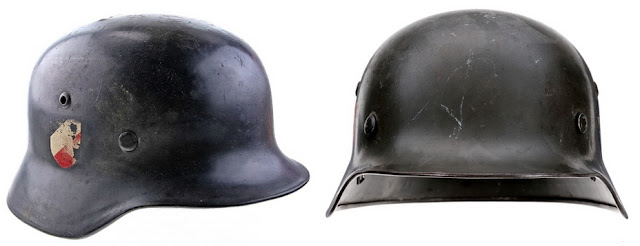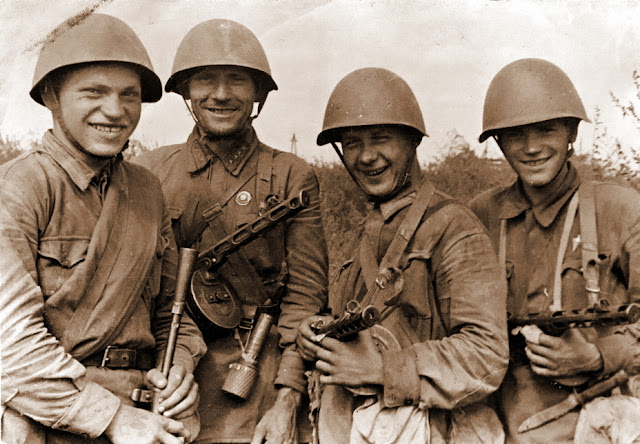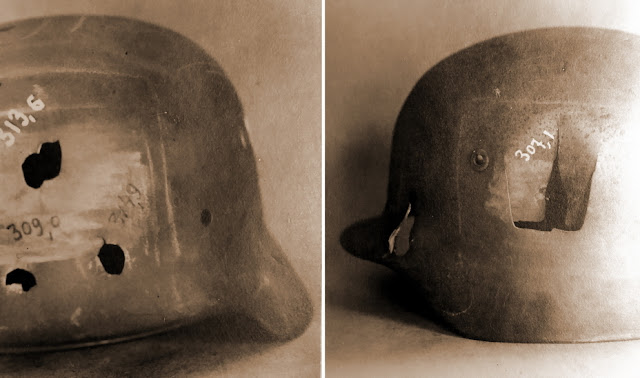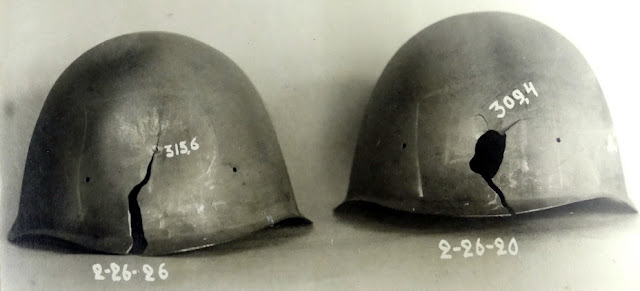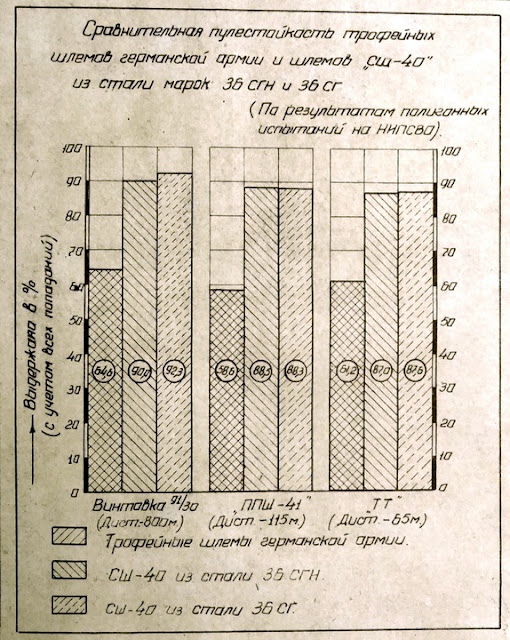Comparisons of one's own weapons and equipment to the enemy's was not just a pastime of common soldiers, but of senior officers as well. Throughout the Great Patriotic War, captured equipment was thoroughly tested and studied. In our days, much attention is paid to comparisons of tanks, planes, and guns. However, it is interesting to learn about similar trials for more common, but no less important, elements of a soldier's kit. The question was simple: which helmet is better, a Soviet one or a German one? The answer came from a commission of the Main Quartermaster Directorate of the Red Army in January-February of 1943.
The first mass produced Soviet helmet, the SSh-36, was introduced into the RKKA in 1936, and it became clear by the end of the year that it had a large number of drawbacks. The most major ones were the brittleness of its steel and low resistance to bullets near areas where it was bent. Attempts to improve the helmets led to a number of experimental prototypes, some of which underwent military trials.
Red Armymen in SSh-36 helmets.
In June of 1939, the RKKA adopted the SSh-39 steel helmet, which got rid of most of the drawbacks of the SSh-36. However, the war with Finland showed that it was impossible to wear it over a warm hat, and the special wool caps designed for wear with the SSh-39 did not protect against harsh cold and frostbite. A new liner was designed for the SSh-39 because of this, which began production in December of 1940. Later, this modification was indexed SSh-40. In June of 1941, the USSR entered the war with three types of helmets: SSh-36, SSh-39, and SSh-40. The first two types were already out of production by then, but were still available in large numbers.
At the time of the invasion of the USSR, Nazi Germany used a much larger variety of steel helmets, from WWI era M16, M17, and M18 to more modern M35 and M40.
Soviet SSh-40 steel helmet.
In 1941, the main helmets of German troops were the M35 and M40. Older models were almost never used on the front lines, but were common in rear line units. The reason for this was that they were unsatisfactory in several ways, including resistance to bullets.
The new helmet adopted by the German land army and navy on June 25th, 1935, was given the name "steel helmet model 1935", or M1935 (or just M35) for short. The basic design was similar to the M16, the 1916 model, but the new model had shorter sides and peak, different ventilation openings, and weighed less.
On October 29th, 1938, a modification of the M35 was patented. The modification was simpler to produce and altered chemical composition of the steel. This modification was accepted into service on March 26th, 1940. The modernized steel helmet received the name "steel helmet model 1940" (as well as M1940 or just M40).
German steel helmet model 1935.
In the first year of the war, it became clear that neither side will reach a quick victory. Millions of soldiers were drafted, all of which had to be armed and equipped. A need to increase production of all equipment, including helmets, arose. In these conditions, the design had to be as cheap and simple as possible, a goal pursued by both sides. In parallel, work was underway to find a replacement for expensive and rare alloying agents in the steel, without harming the protective characteristics, if possible.
In Germany, the result was the adoption of the "steel helmet model 1942" (also M1942 or M42). The M42 entered mass production on August 1st, 1942. They were simpler to produce and were made of cheaper steel. The M42 was used alongside the M35 and M40 until the end of the war, slowly replacing them.
German soldiers in M35 or M40 helmets.
In the USSR, work was aimed at reducing the number of operations involved in production. Prewar research was also used to find a new steel composition: NII-13 and Lysva metallurgical factory (called "Za Industrializatsiyu", "ZI", "Za Industriyu", "Imeni gazety Industriya", "Industriya", People's Commissariat of Ferrous Metals factory #700, LMZ) worked together on this topic in 1936-40. The result was carbon-silicon-manganese-nickel steel 36SGNA (36SGN), which became the basis for Soviet steel helmets. At the factory, this steel was indexed I-1, and used to make breastplates, in addition to helmets. It used expensive and rare alloying agents, which were in short supply during the war. A replacement for these additives needed to be found.
Several variants for replacement of I-1 steel were proposed in the spring of 1942, and they were tested immediately. Large batches of steel helmets were made from experimental steel and sent to the front lines. 36SGA (36SG) steel, tested in 1939, was accepted under the index I-2. This steel had a lot less nickel in it than I-1, and was slightly less bulletproof as a result. In total, 14 types of steel were tested, but I-1 was restored when the supply situation improved.
Soviet soldiers in SSh-39 and SSh-40 helmets.
Soldiers on both sides think of a reasonable question when fighting: whose equipment and weapons are better? Equipment that is considered superior becomes a desired trophy and it used often in everyday life or in battle. There are many examples of this phenomenon. Senior commanders asked the same questions. Often, a comparison of captured equipment with one's own resulted in inspiration to improve equipment and weapons, or create new types.
In December of 1942, under orders from a member of the State Committee of Defense, I. Mikoyan, a commission was formed, led by the Deputy Chief Quartermaster of the Red Army, Major-General Ya.S. Kolesnikov. Its task was to perform comparative trials of domestic and German steel helmets. The commission included representatives of the Main Quartermaster Directorate (GIU), People's Commissariat of Ferrous Metals (NKChM), factory #700, and the NII-13 armour lab.
Trials were performed in two stages. The first took place on January 10-16th, 1943, at the Lysva factory shooting range. The second, February 7-12th, was held at the Scientific Research Small Arms Proving Grounds of the Main Artillery Directorate (NIPSVO GAU), in Schurovo, near Moscow. SSh-40 helmets made from I-1 and I-2 steel were tested, as well as captured German helmets.
German helmets with satisfactory penetrations.
Sadly, German helmets were not sorted by type, and all kinds were tested equally, even though the six different models (M16, M17, M18, M35, M40, and M42) had significant differences. The record table shows that helmets of different sizes were tested, and the table of chemical compositions and hardnesses, determined at factory #700 and NIPSVO, shows that these were different types of helmets. Some rows of the table show the factory markings, which allows one to conclude that helmets from different factories were used.
The trials did not just include analysis of the chemical composition of helmets. The most interesting part was shooting and striking with fragments, which showed whose helmet was better.
The first stage of the trials involved shooting with the 7.62 mm Mosin mod. 1891/30 rifle with a mod. 1908 bullet and reduced propellant cartridge (simulating 800, 900, and 1000 meters due to the short length of the shooting range at factory #700) and a 7.62 mm Nagant mod. 1895 revolver at a range of 10 meters.
SSh-40 after trials.
At the second stage of the trials, the helmets were shot at with the same rifle and bullet at ranges of 800, 900, and 1000 meters, with the PPSh at 115 meters, and TT at 65 meters. Finally, 82 mm mortar shells were detonated 2 meters away.
The shooting at the range and proving grounds was done against helmets with their liners removed from three sides: front, side, and rear. Only hits on certain parts of the helmet counted, ricochets, hits closer than 20 mm to another hit or a ventilation opening did not count. At the proving grounds, the requirements for satisfactory hits were somewhat relaxed due to more realistic conditions.
The depth of dents on surviving helmets was recorded, and written down in two journals in parallel. In addition, factory #700 recorded the speed of the bullet. These tight conditions allowed an objective evaluation of factory #700's products in comparison with German helmets.
620 SSh-40 helmets made from 36SGN steel were submitted for trials, 298 helmets made from 36SG steel, and 270 German helmets. Experimental helmets made with unijunction stamping were also tested: 100 made from 36SGN steel and 60 made from 36SG steel. A portion of the SSh-40 helmets were made with thickened sides.
The trials had to answer several questions:
- Do the SSh-40 helmets meet technical requirements?
- What is the resistance of 36SGN and 36SG steels to bullets?
- What are the advantages and disadvantages of helmets with thicker sides compared to normal (1.14-1.22 mm vs 1.20-1.38 mm)?
- What is the comparative resistance of domestic and German helmets?
- Are the technical conditions of helmets made from 36SG steel such that they can be accepted into permanent service?
Comparative resistance to bullets of SSh-40 helmets made from 36SGN and 36SG steel and German helmets.
Percentage of resisted hits (as a ratio of all hits).
Percentage of resisted hits (as a ratio of all hits).
Groups: mod. 1891/30 rifle from 800 m, PPSh-41 from 115 m, TT from 65 m.
Bars: Captured German army helmets, SSh-40 from 36SGN steel, SSh-40 from 36SG steel.
Trials showed that SSh-40 helmets made from 36SGN steel fully satisfy technical requirements, both wartime and pre-war. It was noted that the wartime technical requirements should be cancelled, and pre-war requirements returned, since it was a "less reliable criterion for evaluating the quality of helmets".
During shooting, 990 shots hit from the rifle with reduced charge, 462 from the rifle with a regular charge, 171 with the revolver, 811 with the PPSh, and 552 with the TT.
Trials showed that 36SG steel was almost equivalent to 36SGN steel, and achieves resistance that satisfies requirements. The commission allowed the application of the same requirements to 36SG and 36SGN steels. A decision was made to allow 36SG steel into mass production alongside 36SGN. The production process used by factory #700 to produce SSh-40 helmets (stamping, hardening) was considered correct.
It was noted that the thickness of the walls impacts resistance to bullets. A recommendation was made to set the minimal thickness of the walls to 1.20 mm, and the maximum thickness to 1.41 mm. This would result in the increase of a 2nd size SSh-40 helmet by 55 grams.
It was established that the resistance of domestic helmets was significantly higher than that of German helmets against all types of bullets. This was caused by the design of the SSh-40, which only had a weak spot in the transition from the peak to the front portion (an 8-10 mm wide strip), unlike the German helmets. German helmets had many more weak spots, which could be seen from the locations of penetrations.
Comparative diagram of the resistance of various zones of the SSh-40 and German helmets.
Front, side, and rear.
X axis: distance from helmet rim, mm
Y axis: percentage of penetrations
When shooting with a rifle at 800 meters using a mod. 1908 bullet (counting all hits), Soviet helmets were penetrated 7.7-10% of the time, and German helmets were penetrated 34.5% of the time. The PPSh penetrated German helmets 41.4% of the time, but Soviet helmets only 11.5-11.7% of the time. The TT could penetrate German helmets 38.8% of the time, compared to 12.4-13% for Soviet helmets. Even the Nagant could penetrate German helmets 29% of the time...
The commission concluded that it is necessary to continue the search for stronger types of steel, perfect the production methods, and continue to improve the shape of the helmet. In addition, the design of the liner could be improved. Even though the selection of German helmets was not ideal, the comparison was definitely in favour of Soviet steel helmets.


